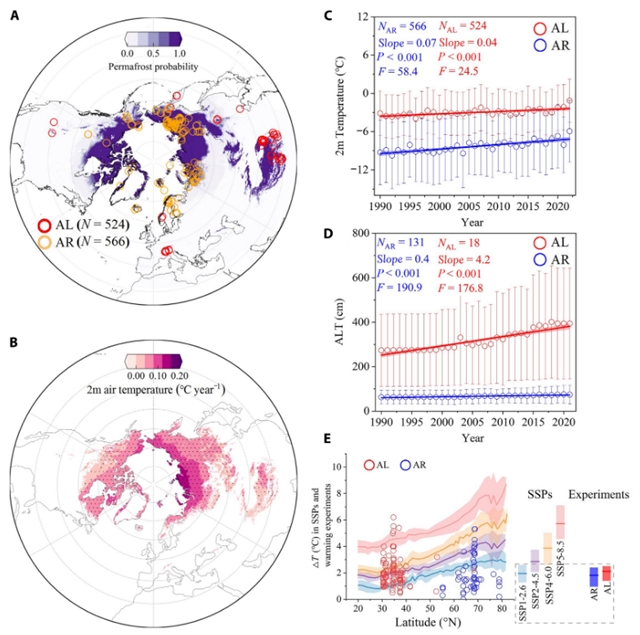
近日,中国科学院大气物理研究所徐希燕团队研究了气候变暖下北极和高山永久冻土之间的气候-碳反馈权衡。2025年9月19日出版的《科学-进展》杂志发表了这项成果。
在气候变暖的情况下,永久冻土的温室气体(GHG)排放是否会引发积极的气候反馈尚不清楚。
研究组综合了生长季二氧化碳(CO2)、甲烷(CH4)和氧化亚氮(N2O)排放对实验所控制的升温~2°C对高寒和北极地区永久冻土的响应。变暖削弱了高山永久冻土的温室气体汇,从而增加了其全球变暖潜势(13%),但增强了北极永久冻土的温室气体汇,减少了(10%)的全球变暖潜力。当气候变暖导致高寒多年冻土区土壤干燥时,CO2汇减弱而CH4汇增加。
相比之下,相对潮湿的北极永久冻土变暖增加了CO2汇和CH4的强度。气候变暖导致高山地区N2O浓度的增加比北极永久冻土要强烈得多。虽然将永久冻土区的额外升温控制在2°C以下可以避免永久冻土-气候正反馈,但需要采取措施来维持高山永久冻土区生态系统脆弱的碳汇。
附:英文原文
Title: Climate-carbon feedback tradeoff between Arctic and alpine permafrost under warming
Author: Tao Bao, Xiyan Xu, Gensuo Jia, Xingru Zhu, William J. Riley, Yuanhe Yang
Issue&Volume: 2025-09-19
Abstract: Whether greenhouse gas (GHG) emissions from permafrost will trigger positive climate feedbacks under warming remains unknown. Here, we synthesized the response of growing season carbon dioxide (CO2), methane (CH4), and nitrous oxide (N2O) emissions to experimentally manipulated warming of ~2°C for permafrost in alpine and Arctic regions. Warming weakened the GHG sink of alpine permafrost, thereby increasing (13%) its global warming potential, but strengthened the GHG sink of Arctic permafrost and decreased (10%) its global warming potential. When warming caused drying of alpine permafrost soils, the CO2 sink weakened but the CH4 sink increased. In contrast, warming of relatively wet Arctic permafrost increased the CO2 sink and CH4 source. Warming led to much stronger increases of the N2O source in alpine than Arctic permafrost. Although keeping additional warming below 2°C in permafrost regions can avoid the positive permafrost-climate feedback, measures are needed to maintain fragile carbon sink of alpine permafrost ecosystems.
DOI: adt8366
Source: https://www.science.org/doi/10.1126/sciadv.adt8366
